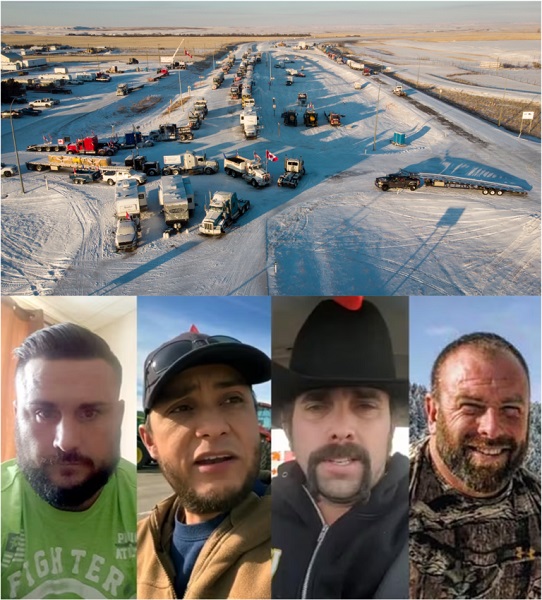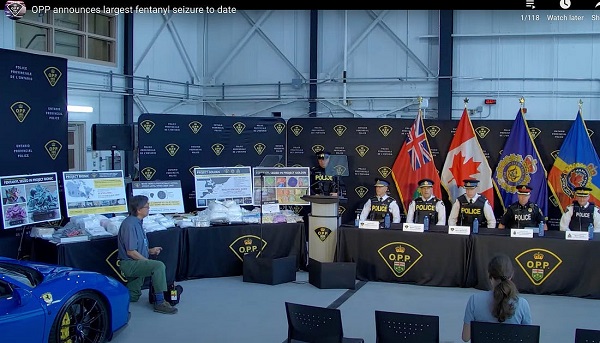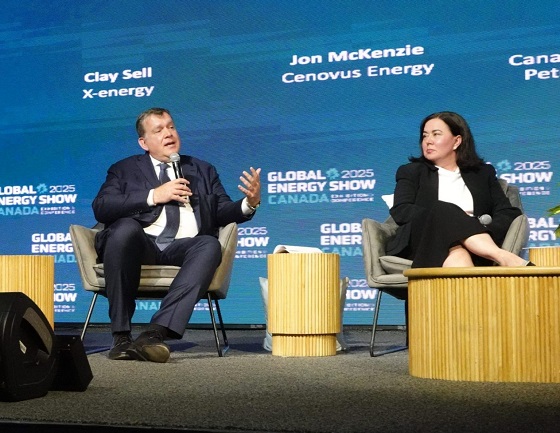Frontier Centre for Public Policy
The Worrisome Wave of Politicized Prosecutions

Unusual punishment: The 2022 truckers’ protest at the Coutts, Alberta border crossing (top) led to charges against four men (bottom left to right), Chris Carbert, Tony Olienick, Jerry Morin and Chris Lysak; Morin and Lysak were held in custody for almost two years while the other two are still in prison. (Sources of photos: (top) The Canadian Press/Jeff Mcintosh; (bottom) CBC)
From the C2C Journal
By Gwyn Morgan
Shaping criminal charges, bail decisions or prison sentences around an accused person’s political or religious beliefs is utterly odious – a hallmark of tinpot tyrannies and totalitarian hellholes. Such practices have no place in any constitutional nation, let alone a mature democracy that presents itself as a model to the world. But that is increasingly the situation in Canada, writes Gwyn Morgan. Comparing the treatment of protesters accused of minor infractions to those of incorrigible criminals who maim and kill, Morgan finds a yawning mismatch that suggests political motivations are increasingly a factor in today’s criminal justice system.
On January 29, 2022, a small convoy of trucks headed down to the U.S. border crossing at Coutts, Alberta to join in the nationwide protests against the Covid-19 vaccine mandate that the Justin Trudeau government had recently imposed on cross-border truckers – the very people Trudeau had previously described as “heroes” for delivering food and other essentials in the depths of the pandemic. Joined by many locals in pickup trucks and farm machinery, the truckers’ border protest turned into a full-scale blockade that would last 17 days. Just as it appeared to be settling into an extended stalemate, heavily armed police tactical teams swooped down upon several locations and arrested 14 protesters, charging four with the ominous crimes of conspiracy to commit murder (of police officers), mischief, a raft of weapons offences and uttering threats. These were bewildering accusations given the overall context of the event.
As the blockade almost instantly dissolved given that none of the protesters wanted to be linked to potentially violent offenders, the four men – Chris Lysak, Jerry Morin, Chris Carbert and Tony Olienick – were locked away. Lysak and Morin spent 723 days – nearly two years – in pre-trial custody, 74 of which Morin was kept in solitary confinement. Finally, after their new lawyer, Daniel Song, filed a Charter of Rights and Freedoms application demanding that the courts re-examine the case, the Crown suddenly accepted a plea deal on much lesser firearms charges. One month ago – on February 6 – Morin and Lysak were abruptly released. But they had already served the equivalent of a typical sentence for a serious crime in Canada – manslaughter or assault, say. Hard-working tradesmen with young families, Morin and Lysak will never get those two years back. Carbert and Olienick remain in prison and still face the full raft of charges; their trial is to begin in May.
Contrast this with the recent case of a mother and daughter – Carolann Robillard and Sara Miller, 11 – who were fatally stabbed in a horrific random attack outside an Edmonton school. Their accused killer, Muorater Arkangelo Mashar, had a long criminal record of assaults, assault with a weapon and robbery; he had been released from custody 18 days prior to the murders. Such events are no longer exceptions in Canada’s criminal justice system. They’re not cases of someone “falling through the cracks” – getting out due to a glitch or individual act of incompetence. They are routine. This is how things are now done in Canada. Vancouver police, for example, catch and release the same criminal offenders over and over, sometimes close to 100 times, because they always make bail.
By contrast, the four Coutts protesters were repeatedly denied bail despite having no criminal records. For this reason, social media users raised the possibility that they were, in effect, political prisoners being persecuted for having stood up so defiantly against the vaccine mandate and embarrassing Trudeau. Just a week or so following their arrests, over 3,000 km away on Parliament Hill, the Trudeau government moved against a peaceful protest that was breaking no significant laws other than, possibly, some municipal noise ordnances and parking bylaws. Police arrested and incarcerated four prominent protesters whom there was no credible basis to imprison and hold without bail. Of the four, Chris Barber was released within a day. Pat King and George Billings, however, were denied bail despite facing only minor mischief charges; they would spend months in jail. Billings eventually pled guilty to one charge and was released, while King’s trial has yet to begin.

Political prisoners: At the Freedom Convoy protest in Ottawa (top), police arrested (bottom left to right) Chris Barber, Pat King and George Billings; Barber was released but King and Billings were denied bail despite facing only minor mischief charges. (Sources of photos: (top) Maksim Sokolov (Maxergon), licensed under CC BY-SA 4.0; (bottom left) Public Order Emergency Commission; (bottom middle) Calgary Herald; (bottom right) The South Peace News)
Alberta
Too Graphic For A Press Conference But Fine For Kids In School?

From the Frontier Centre for Public Policy
By Lee Harding
Alberta moves to remove books after disturbing content, too graphic for media to view, was found in schools
Should elementary school children be given books to read with harsh insults against minorities, depictions of oral sex, and other disturbingly graphic and explicit content?
Such books have been in some Alberta elementary schools for a while, and in many school libraries across Canada.
In late May, the Alberta government announced it would establish new guidelines regarding age-appropriate materials in its schools. A government press release included quotes with disturbing content, but at a press conference, Education Minister Demetrios Nicolaides said some book illustrations could not be shown.
“I would show these images to all of you here and to the media, but they are too graphic for a live-stream media event. These examples … illustrate the kind of content that raises concerns amongst parents,” Nicolaides said.
You don’t say? This seems like the sort of stuff no one, except a pervert in a park, would dream of showing to a child. Ironically, the inability to publicize such graphic materials is part of the reason they have been shown to children with little public awareness.
Citizens’ group Action4Canada (A4C) has claimed its activism played a pivotal role in the Alberta decision. The organization has compiled a 36-page document online with examples of objectionable content in Canadian schools. Among the worst is Identical by Ellen Hopkins, which includes graphic descriptions of a little girl being molested by her father.
A4C founder Tanya Gaw has repeatedly tried to raise concerns about objectionable books with school boards, often without success. In some cases, she isn’t even allowed on the agenda if she states her topic upfront. When she is permitted to speak, she’s frequently cut off as soon as she begins quoting from the books, preventing the content from entering the public record.
In January 2023, Gaw made an online presentation to a school board in Mission, B.C. regarding materials in their schools. As she began to screenshare what was there, some board members objected, saying such permission had not been given in advance.
One month later, the board banned Action4Canada from making any further presentations. In later media interviews, the board chair justified the decision by saying Gaw’s PowerPoint contained some graphic and “inappropriate images.”
Exactly, and that is the problem. A recent check showed Mission’s school division only removed four of 15 books A4C objected to. Gaw is just glad “Identical” is one of them.
Pierre Barns, a father from Abbotsford, B.C., made it his mission to notify school boards across Canada what was on their school shelves. An online search was all it took to confirm. A “reply all” from a board member at the Halton School District in Ontario was most ironic.
“I am concerned. This individual has included links to publications and videos which may contain illegal content,” she wrote.
“I’m not sure how to investigate the content of the email safely. Would you please advise us whether or not this person ought to be reported to police? Is there some action we should take?”
There probably was action they should have taken, such as removing the books, but that never happened. Later, they defended a biologically male teacher in their school division who made international headlines by wearing large prosthetic breasts to school.
The Alberta government has committed to conducting public consultations before implementing new policies. It’s a good time for parents and citizens there and in other provinces to speak up. A young mind is a terrible thing to corrupt, but unfortunately, some schools are part of this corrosive effort.
Lee Harding is a research fellow with the Frontier Centre for Public Policy.
Economy
Canada Treats Energy As A Liability. The World Sees It As Power

From the Frontier Institute for Public Policy
Research VP Marco Navarro-Genie warns that Canada’s future hinges on building energy infrastructure, not just expanding pipelines but forging a true North American energy alliance. With global demand rising and authoritarian regimes weaponizing energy, Ottawa’s dithering costs Canada $70 million daily. Sovereignty isn’t secured by speeches but by infrastructure. Until Canada sheds its regulatory paralysis, it will remain a discount supplier in a high stakes geopolitical game. Time to build.
Canada has energy the world is begging for, but ideology and red tape are holding us back
As Prime Minister Mark Carney met with U.S. President Donald Trump recently, energy should have been the issue behind every headline, whether mentioned or not. Canada’s future as a sovereign, economically resilient country will depend in no small part on whether the country seizes this moment or stalls out again in a fog of regulatory inertia and political ambivalence. Canada holds an underleveraged strategic card: the potential to be the world’s most reliable democratic energy supplier. Recent trade figures show Chinese imports of Canadian crude hit a record 7.3 million barrels in March, a direct result of newly expanded access to the Pacific via the Trans Mountain Expansion (TMX), a federally owned pipeline project that now connects Alberta crude to global markets through British Columbia’s coast. But one pipeline does not make a national strategy. Demand in Asia is growing fast. India is among the hungriest, but Canada’s infrastructure is nowhere near meeting that demand.
This matters not just for Canada, but for the United States as well. In a world where energy markets are weaponized and strategic reserves manipulated by authoritarian regimes, the case for a coordinated North American energy alliance is stronger than ever. Such an alliance should not erode national sovereignty. It should reinforce it, allowing Canada, the U.S. and Mexico to insulate themselves collectively from supply shocks and geopolitical blackmail while projecting democratic strength abroad.
But for that alliance to work, Canada must be a credible partner, not merely a junior supplier shackled by Ottawa-induced internal bottlenecks. While the U.S. has leveraged its shale revolution, LNG capacity and permitting reforms to pursue energy dominance, Canada dithers. Projects languish. Investment flees. And meanwhile, Canadian oil continues to flow south at a steep discount, only to be refined and resold, often back to us or our trading partners, at full global prices.

Yes, you read that right. Canada’s oil and gas is sold at a discount to U.S. customers, and that discount costs Canada more than $70 million every single day. The Frontier Centre for Public Policy has developed a real-time tracker to monitor these losses. This pricing gap exists because Canada lacks sufficient pipeline infrastructure to access overseas buyers directly, forcing producers to sell to the U.S., often at below-market rates.
Such massive losses should be unacceptable to any government serious about economic growth, geopolitical influence or environmental integrity. Yet Ottawa continues to speak the language of ambition while legislating the mechanics of paralysis. Stephen Guilbault’s statement that Canada already has enough pipelines speaks to more paralysis..
Canada’s energy infrastructure challenges are not just economic; they are matters of national defence. No country can claim to be secure while relying on another’s pipelines to transport its energy across its own territory. No country can afford to leave its wealth-producing regions boxed in by regulatory choke points or political resistance dressed as environmental virtue.
Our energy economy is fragmented. Western hydrocarbons are stuck inland and must pass through the U.S. to reach Eastern Canada or global markets eastward. This weakens national unity and leaves us exposed to foreign leverage. It also creates strategic vulnerabilities for our allies. American industries depend on Canadian crude. So do U.S. Gulf Coast refineries. And while American officials continue to treat energy as a tool of diplomacy and economic leverage, using energy exports to build alliances and reduce reliance on unstable regimes, Canada treats it as a domestic liability.
We need to shift the frame. Infrastructure isn’t just about steel in the ground; it’s the backbone of strategic autonomy. Pipelines, export terminals and utility corridors would allow Canada to claim its place in the emerging geopolitical order. They would also signal to global investors that Canada is open for business and capable of delivering returns without political obstruction.
The U.S. wants a stable, competent partner to help meet global energy needs. Increasingly, so does the rest of the world. But until we address our internal dysfunction and build, we’re stuck. Stuck watching global opportunities pass us by. Stuck selling low while others sell high. Stuck in a conversation about sovereignty we’re not structurally equipped to address, let alone win.
When Carney meets with Trump again, he would do well to remember that economic independence, not rhetorical unity, is the bedrock of sovereignty. Without infrastructure, Canada brings only words to a hard-power conversation.
Paraphrasing Thomas Hobbes, energy covenants without infrastructure are but words. It’s time to stop posturing and start building.
Marco Navarro-Genie is the vice-president of research at the Frontier Centre for Public Policy. He is co-author, with Barry Cooper, of Canada’s COVID: The Story of a Pandemic Moral Panic (2023).
-

 Health20 hours ago
Health20 hours agoLast day and last chance to win this dream home! Support the 2025 Red Deer Hospital Lottery before midnight!
-

 Business2 days ago
Business2 days agoCarney’s European pivot could quietly reshape Canada’s sovereignty
-

 Alberta2 days ago
Alberta2 days agoAlberta’s grand bargain with Canada includes a new pipeline to Prince Rupert
-

 conflict1 day ago
conflict1 day ago“Evacuate”: Netanyahu Warns Tehran as Israel Expands Strikes on Iran’s Military Command
-

 Aristotle Foundation24 hours ago
Aristotle Foundation24 hours agoThe Canadian Medical Association’s inexplicable stance on pediatric gender medicine
-

 Energy1 day ago
Energy1 day agoCould the G7 Summit in Alberta be a historic moment for Canadian energy?
-

 Crime1 day ago
Crime1 day agoMinnesota shooter arrested after 48-hour manhunt
-

 Bruce Dowbiggin1 day ago
Bruce Dowbiggin1 day agoWOKE NBA Stars Seems Natural For CDN Advertisers. Why Won’t They Bite?









